
Last week, the Podcast Movement conference took place in Denver, Colorado. The annual gathering of professional and hobbyist podcasters has become a must-attend event for folks who work in the world of on-demand audio.
I once again hosted the Podcast Makeover session, in which a panel of podcasting and broadcasting professionals critique the first 30 seconds of episodes from up-and-coming podcasters. The session is a rare opportunity for podcasters to experience the ritual that us radio folks know as “the aircheck session.” A special thanks to my panelists this year: Colorado Public Radio’s Chandra Thomas Whitfield, CityCast Denver’s Paul Karolyi, Libsyn’s Elsie Escobar, and Matty Staudt from Jam Street Media.

The other sessions at this year’s conference covered the usual topics — from editing to marketing to monetization — as well as some that, while not new, were certainly given more attention, including video and A.I.
So what were the big takeaways this year? I asked an assortment of colleagues who attended. Here’s what they had to say…
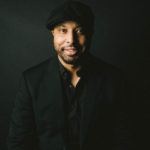
“This is my seventh Podcast Movement. It’s my go-to conference to stay up-to-date on the latest trends and information in the podcasting industry. The main themes I pulled from this past conference are video podcasts over audio podcasts and AI is here to stay. And even though technology was a big focus of this conference, I actually made more genuine connections at this Podcast Movement than any other.”
Shannon Cason, Host of Homemade Stories
The Rise of Video in Podcasting
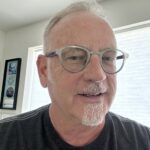
When I asked Dave Beasing, CEO of the branded podcast production company Sound That BRANDS (and a Jacobs Media alumnus) for his big takeaway, his answer was simple: “Video. Video. Video.”
Indeed, all week, there were a slew of announcements related to video: Steve McLendon, the Product Lead Podcasting at Google, declared that YouTube will be ingesting RSS feeds before the end of the year (speaker Paul Colligan reported working with one podcast that has already been “ingested”);
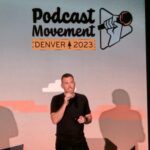
Austin Lamon, Spotify’s Director of Podcast Product, announced a number of new features to help podcasters get discovered, including incorporating video snippets; and Triton Digital announced that it will now include YouTube views alongside download numbers in its metrics services.
Others echoed the importance of video in podcasting. Steve Goldstein, the CEO of Amplifi Media, said:
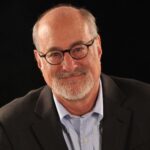
“We presented some really important data with Coleman Insights about YouTube and its impact on the business at a Thursday keynote. The definition of a podcast is changing. Podcast consumption is mostly happening on three big platforms: Apple, Spotify and YouTube. YouTube claims the top spot. That’s a game changer and so it is not surprising that 75% of people now define a podcast as either audio OR video. The implications are pretty wide ranging. Not every podcast needs to be visual, but every podcaster needs to be on YouTube and think through those issues.”
For those who missed the session, Steve will be hosting a free webinar on September 7th. You can register for it here.
Josh Miely, the Vice President of Content Design and Development for the National Association of Broadcasters, believes that one of video’s implications will be on podcast discovery:

“For audio-only podcasters with discoverability challenges, crafting video episodes may be your answer. Roughly a quarter of podcast consumers find new shows on YouTube and capturing video while recording interview-based podcasts has never been easier.”
By day, Shannon Hernandez is a podcast marketing consultant; at night, he transforms into the superhero known as The Shan Man to listeners of 98KUPD in Phoenix. He also pointed to the rise of video, particularly as it relates to podcast discovery, as one of the big themes at this year’s conference:

“In my 11 years in the podcasting space, I’ve seen trends evolve, including the recent shift from audio to audio and video, with YouTube becoming a significant player in the game. Podcast Movement 2023 highlighted the community’s struggle with marketing and defining clear objectives, but also the opportunity to optimize videos for discovery through search engine optimization, pod swaps, and being a guest on other related podcasts, directly impacting community growth. Without a long-term strategy, including embracing platforms like YouTube, podcasters may miss opportunities to turn their passion into a thriving business.”
Several of Shannon’s colleagues from Hubbard Radio made the trek to Denver, including Jeremy Sinon, Hubbard’s VP of Digital Strategy. Jeremy also noted the rise of video’s role in podcasting:
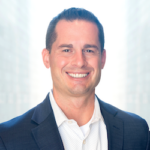
“There were several underlying themes at this year’s Podcast Movement, but to me the most glaring was the seemingly unstoppable momentum towards video. With YouTube, Spotify and even TikTok pushing hard, it’s obvious that they see big potential here. The video train is leaving the station. All aboard for greater audience discovery and a shot at video CPMs which could/should be higher than podcast CPMs.”
Sheryl Worsley, Vice President of Podcasting for Bonneville and KSL Podcasts, singled out YouTube for the role it could play in podcast discovery:
“If you don’t have at least clips of your podcast or of the host promoting your podcast up on YouTube, you are missing a huge opportunity. Discovery happens on YouTube and so does a great deal of listening.”
Beyond just discover, Sheryl thinks the new emphasis on video will actually shape the form of podcast content:

“We have already seen the larger shops lean more towards interview style shows. You have watched as the Amazons, the Lemonada Medias, IHearts, etc., have found ‘celebrity A’ or ‘YouTuber/influencer B’ and launched a glut of shows where they interview people. The cost to produce is generally lower and the weekly release of episodes creates a desirable, constant pipeline of inventory to attract and keep advertisers to the show. The rise of YouTube for podcasting is only going to increase this trend. Setting your host and guest up with a mic and headphones (or just lav mics) in a well-lit area while they discuss things is not difficult. If done correctly, the audio can be stripped from the video and uploaded in all the RSS places. Many of these shows do a great job. If you have one of these shows, check your quality. More great shows in this space will create a glut of fantastic interview-style content.”
But if video causes a massive shift to interview-style podcasts, what does that mean for those who are producing long-form storytelling journalism? Sheryl has a theory:
“Those who produce narrative, long form seasonal shows will also need to keep quality high. The good news is the content will become more rare because it is not as easily produced and it stands out in a sea of interview shows. Because it is more rare, it could increase demand.”
Matt Cundill, the owner and operator of Sound Off Media Company, said:
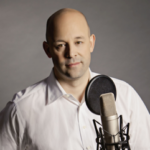
“Every podcaster needs to consider their YouTube strategy. After serving up large Nothing Burger announcements over the last few years, Steve McLendon answered a number of (pre-selected) questions regarding YouTube’s future plans with podcasting. He confirmed that YouTube will entertain an RSS feed for creators in YouTube Music which will be available worldwide by early 2024. McLendon added that it was consumer consumption of podcast shows on YouTube that encouraged this move; something reinforced by Jay Nachlis from Coleman Insights and Steve Goldstein from Amplifi Media during their keynote presentation: ‘The New Rules Of Podcasting on YouTube.'”
Broadcasting veteran Jon Gay is the Founder and CEO of JAG in Detroit Podcasts, a podcast production company. He also zeroed in on YouTube’s impact on podcasting:

“Every podcaster needs a YouTube strategy: While opinions remain divided on how exactly it will fit into the podcast ecosystem, YouTube has made strides to accommodate the podcasters who have embraced the platform. Even if a podcast is audio-only, it needs to be available for consumption on YouTube. While some ‘OG’ podcasters argue that YouTube’s technical specs do not make it a podcast (currently), it’s clear that consumers are…well…consuming on the platform.”
Artificial Intelligence in Podcasting
There were numerous sessions that addressed the impact of A.I. on the podcasting space. Some focused on how current tools, such as Descript or Adobe Audition, are incorporating A.I. into their workflow. Others introduced A.I. tools specifically designed to performs tasks for podcasters, such as summarizing episodes and creating show notes or social media posts. Still other sessions asked the larger questions that we’ve been asking in the radio industry, such as “Will A.I. take our jobs?” and “Will A.I. be able to create podcast episodes on their own?”
Despite all the chatter, few people I asked cited the use of A.I. as one of their biggest takeaways from the conference. Jon Gay told me:
“You can’t fake it in podcasting. While AI tools have a valuable place in shortening workflow, content that is too obviously AI created will drive away your audience.”
One of the more unexpected takeaways came from Dave Jackson, a podcast consultant and the founder of School of Podcasting:

“One thing I love about conferences is you get different perspectives about the same subject (podcasting). For example, ‘You should devise a safe word in case someone clones your voice and calls your older parents demanding a ransom.’ That one had never crossed my mind, but it is something I probably should do.”
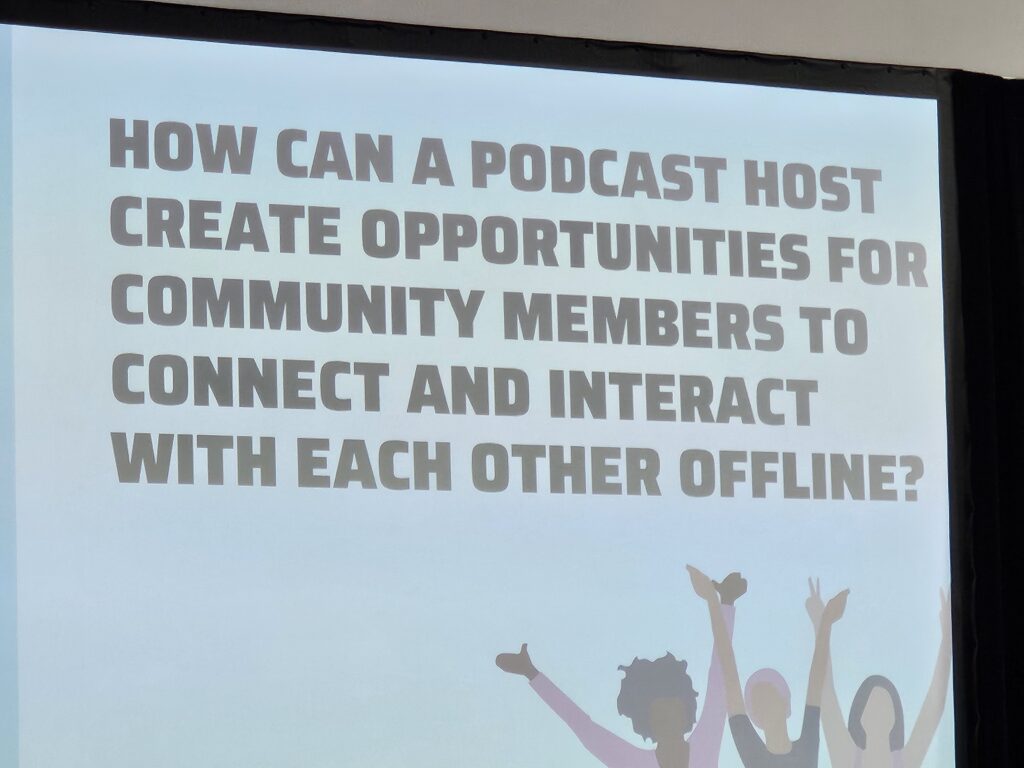
The Importance of Community
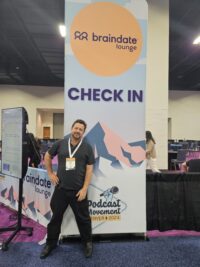 Regular readers of this column — We’re now up to three! Yay! — know that community building has been a hot topic of mine for a few years now. At Podcast Movement, I hosted a “braindate” — a roundtable discussion about how to transform an audience into a community. (Remember: An 👏 Audience. 👏 Is. 👏 Not. 👏 A. 👏 Community.) I wasn’t sure what kind of attendance to expect, but we had a full table and a lively discussion involving a state senator, a political cartoonist, two entrepreneurs, a radio broadcaster, and a health and wellness podcaster.
Regular readers of this column — We’re now up to three! Yay! — know that community building has been a hot topic of mine for a few years now. At Podcast Movement, I hosted a “braindate” — a roundtable discussion about how to transform an audience into a community. (Remember: An 👏 Audience. 👏 Is. 👏 Not. 👏 A. 👏 Community.) I wasn’t sure what kind of attendance to expect, but we had a full table and a lively discussion involving a state senator, a political cartoonist, two entrepreneurs, a radio broadcaster, and a health and wellness podcaster.
Turns out, I wasn’t the only person talking about community at the conference. Anna DeShawn, the Co-Founder and CEO of The Qube, who also participated in a panel discussion about community, told me:
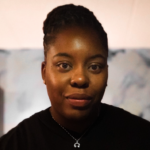
“This Podcast Movement I’m reminded just how impactful ‘in real life (IRL)’ connections are to building your podcast, your business, and your brand. I attend to meet new people and deepen already existing relationships. People want to work with people they like and sometimes talking over Zoom just isn’t enough. So, show up in the spaces that will help you grow and reach your goals.” [emphasis mine]
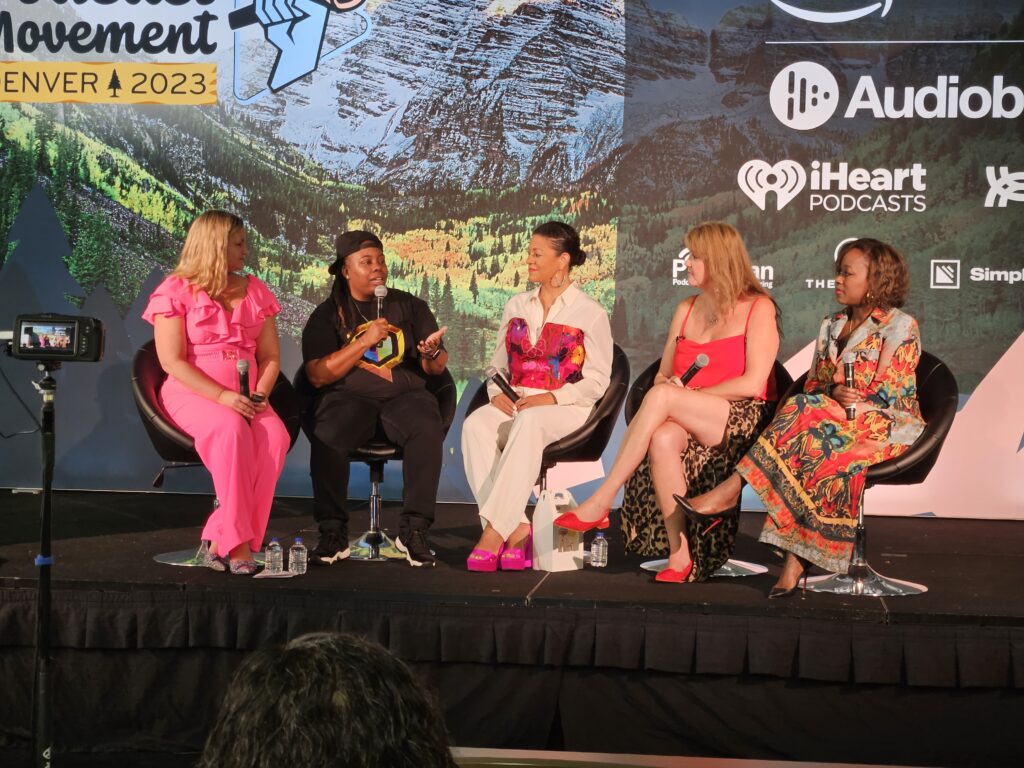
When leading my braindate, I emphasized the distinction between creating content to attract audiences and building spaces where community members can gather. Elsie Escobar, who is the Director of Community and Content at Libsyn, understands the power of gathering in spaces well:

“Social media, like X, Facebook, TikTok, you know, all those platforms, they’re not real life. Deciding stuff and forming opinions only from what you see online doesn’t really match up to the impact and insight you get from actually looking into someone’s eyes, hearing their voice, and catching their vibe in real life.
Being at events such as Podcast Movement is a real gift, and realizing that many folks who could gain so much from these soul-nourishing face-to-face moments simply don’t have the chance or the means to be there – that’s something to reckon with.”
Shannon Hernandez told me that this is a concept that resonates well beyond the podcasting space: “This year’s theme across conferences I have attended has been community building.”
Podcast Movement itself has done an impressive job of building a community of podcasters, and the annual conference serves as a space where its community members can gather. Steve Stewart, a Podcast Editor and Co-founder of the Podcast Editor Academy, shared a story that illustrates the power of these gatherings:

“My biggest takeaway isn’t really about #PM23, but associated with the opportunities that came from being there. As a professional Podcast Editor and long-time podcast enthusiast, I am very interested in the post-production side of podcasting. A favorite podcast is Twenty Thousand Hertz, which talks about the stories behind the world’s most recognizable and interesting sounds.
Not only did I get to meet the host, Dallas Taylor, during the Expo (a total fan-boy moment) – but he also attended my unofficial Podcast Editors meetup. After everyone else had left the meetup, I found myself in a hour-long conversation with Dallas and two of my peers about the pros-and-cons of spatial audio and Dolby Atmos. You don’t get that kind of thing from a Keynote or presentation!”
I had a similar moment when I met Doc Rock, the Community Manager of eCamm Live. I have been using eCamm to produce videos for several years now, and Doc’s video tutorials have been invaluable. While we have exchanged emails in the past, I got a chance to sit down with him and have a lengthy conversation in Denver. Little did I know that Doc is a former radio broadcaster — he used to host afternoon drive on a CHR station in Hawaii. We spent some time swapping radio stories.

The Tools and The Toys
As always, there were tons of booths in the Expo Hall, many of which were demonstrating new hardware and software designed for podcast production. Matt Cundill explained:
“The tools and toys have never been better. Whether it is editing, audio or recording, transcribing, or monetization, there are a plethora of established and startup tools on the trade show floor to get you started or elevate your game. And when I say never been better, I mean remote recording where it can sound like two people are in the same room, repair tools to fix audio blemishes, AI to fix your verbal missteps, and video recording as high as 4k quality. Throw in Descript’s recent purchase of Squadcast, and it’s easier than even to make a high quality show.”
My favorite gadget on display was the Nomono sound capsule, and incredible powerful recording studio that fits into a carrying case the size of a teapot. It features four lavalier microphones, a digital recorder with 8 more mics built in, and a charging base. The unit automatically uploads the recording to the cloud, where it processes it using AI. Podcast Elder Rob Greenlee gave me a demo over breakfast, and now I know what I’m asking Santa for this Christmas.
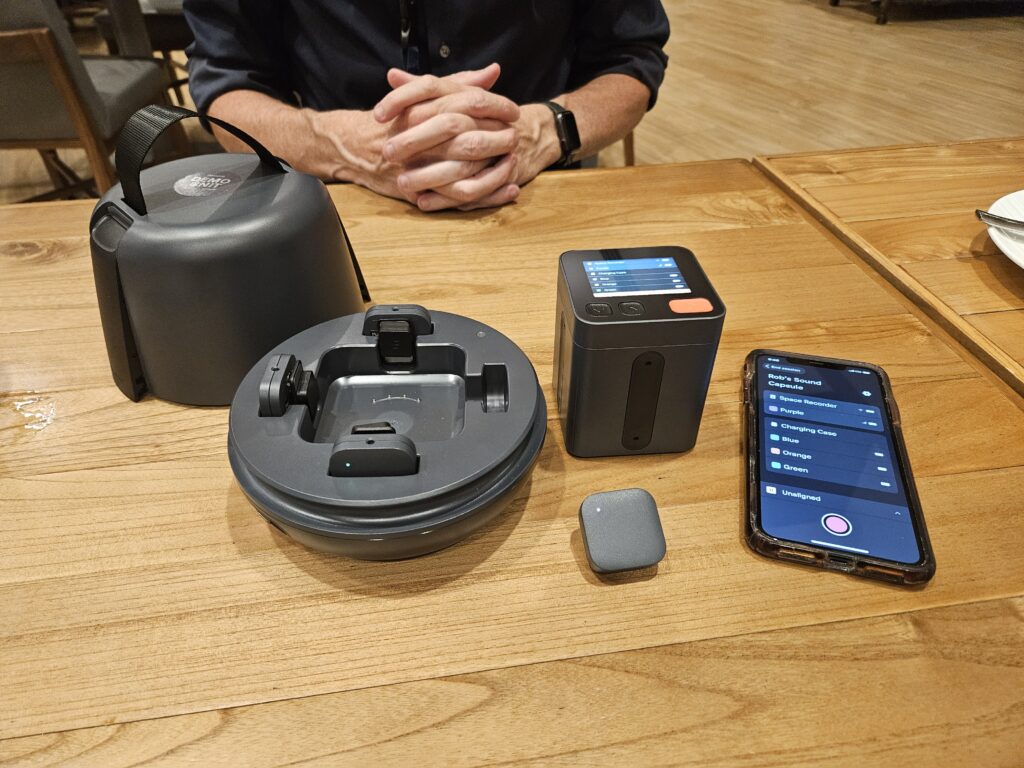

Hear the raw audio from the Nomono sound capsule:
Hear the A.I.-processed Nomono sound capsule recording:
Branded Podcasts

Jacent Jackson is a former radio program director who is now the Senior Producer at Sound That BRANDS, where he spends his time creating podcasts for brands like Mattress Firm and AAA. So he was paying special attention to the discussion around branded projects in Denver:
Final Thoughts
Canadian-looking-in Matt Cundill offered one more takeaway:
“There are still a lot of Americans who don’t listen to podcasts: While podcasting has never been more popular, Gabriel Solo of Edison Research reminds us that many Americans have not found a podcast to engage with. Combined with the ebb of “active” shows amongst the 4 million plus podcasts, we find opportunity: There is no better time than the present to start a high quality show and convert the unconverted to listen to a podcast.”
The final word goes to Matty Staudt, the CEO of Jam Street Media, who has a long history in both broadcasting and podcasting:

“The optimism for the coming year in the industry was everywhere, especially amongst the independent producers. Everyone seemed to agree the shakedown this past year was needed, but was probably an overcorrection and the rest of the year looks great for the industry.”
Thank you to everyone for sharing their thoughts. Thanks also to Dan Franks and Jared Easley and the entire team from Podcast Movement, who always do a fantastic job producing this event.
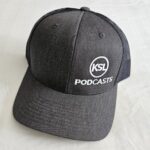
And finally, thank you to Sheryl Worsley for the cool KSL Podcasts hat! We’ll see everybody next year in Washington, D.C.
- A Simple Digital Treat to Thank Your Radio Listeners This Thanksgiving - November 13, 2023
- Interview Questions When Hiring Your Radio Station’s Next Digital Marketing Manager - November 6, 2023
- A Radio Conversation with ChatGPT: Part 2 – Promotions - October 30, 2023





A couple of things come to mind regarding podcasting and they’re good. It’s a great way to accentuate curated audio (some call it “radio”), and the addition of video (Youtube) makes it even more attractive. What could be done to enhance these efforts includes production, visual effects and more planning. If you use video it should be appealing in both the sound and picture. If you’re using audio, you should plan on painting a visual picture in the listener’s mind.
In all cases these media have a way of taking attention away from the traditional sources-(radio and TV)- and will have an effect on those numbers. It would be nice if podcasters realize that their traditional counterparts are competition -as much as traditional audio and video (radio/TV) should realize there’s a new kid in town looking to steal your attention. Each should (operative here is “should”) make the other one better. Maybe someday it will.
Thanks, Dave! These days, if you’re a media company, you have to be a multi-media company. You may have a primary medium (such as radio), but you’ve got to be engaged in other forms (podcasts, video, text, etc.) as well.
I think we’re seeing companies come to the realization that it doesn’t make sense to create content for each of these mediums from scratch — there’s simply too many platforms! Instead, we’ve got to devise plans to produce content in a way that it can be consume on multiple platforms so that audiences can access it however they want.